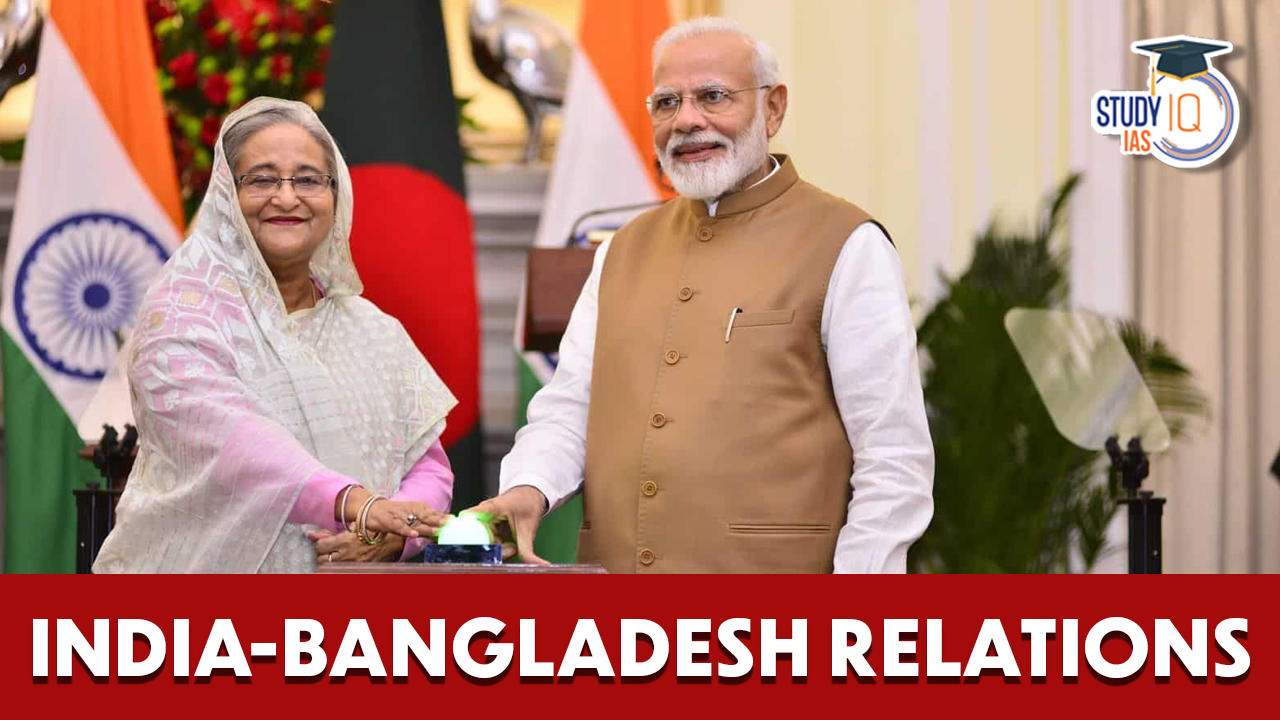Table of Contents
Context: With almost two and a half years of diplomatic experience, the India-Bangladesh friendship is observed to be at its highest level in its 52-year history.
More on News
- During the Prime Ministerial visits in subsequent years, both sides assured maximum cooperation in communication, river water distribution, security, and border management between the two countries.
- The two countries have witnessed significant growth in bilateral trade, with Bangladesh’s exports to India increasing by 100% and India’s exports to Bangladesh increasing by 70%.
- Both countries are in talks to sign a CEPA to further boost trade ties and both are cooperating to deal with potential energy crises, and Bangladesh imports 1,160 MW of electricity from India.
- Several rail line projects between India and Bangladesh are underway to enhance connectivity between the two nations.
- Bangladesh’s government has taken steps to ensure that no activity in Bangladesh endangers India’s geographical integrity and disturbs the stability of its northeastern states.
India-Bangladesh Relations
Historical Ties:
- India and Bangladesh share a 4,096.7 km-long border, making it the longest land boundary that India shares with any of its neighboring countries.
- The relationship between India and Bangladesh is not just that of neighbours, but it is deeply rooted in shared history, heritage, culture, language, and a passion for music, literature, and arts.
- India was the first country to recognize Bangladesh as an independent state and established diplomatic relations immediately after its independence in 1971.
- Both countries are members of regional organizations like SAARC, BIMSTEC, IORA, and the Commonwealth.

Areas of Cooperation:
- Political: India’s support in terms of humanitarian aid, moral support, diplomatic efforts, and military assistance played a crucial role in the liberation of Bangladesh. Sheikh Mujeeb ur Rehman, popularly known as Bang Bandhu, openly recognized that maintaining a friendship with India is a fundamental aspect of Bangladesh’s foreign policy.
- Security & Border Management: Coordinated Border Management plan, signed in 2011, which aims to synergize the efforts of both countries’ border guarding forces in effectively controlling cross-border illegal activities and crimes.
- The India-Bangladesh Land Boundary Agreement (LBA) came into effect in June 2015.
- This agreement facilitated the exchange of enclaves between India and Bangladesh and the signing of strip maps.
- It is expected to enhance border management and address issues related to trafficking, illegal movements, and more.
- The settlement of the maritime boundary arbitration between India and Bangladesh, based on the UNCLOS award in 2014, has opened avenues for economic development in the Bay of Bengal region, benefiting both countries.
- India and Bangladesh have established an annual Coordinated Patrol (CORPAT) as a joint initiative between their navies.
- River Water Management: India and Bangladesh have a shared responsibility for managing the waters of 54 rivers, with Bangladesh being the lower riparian country.
- Being a lower riparian country, Bangladesh faces potential risks and impacts from the rivers originating in India.
- However, India provides Bangladesh with seasonal water flow and rainfall data to assist in flood forecasting.
- To facilitate effective cooperation and maximize the benefits from the common river systems, a bilateral Joint Rivers Commission (JRC) has been operational since 1972.
- The Ganges Waters Treaty, signed in 1996, has also been successful in facilitating the sharing of water from the River Ganges during the lean season.
- Bilateral Trade: The volume of bilateral trade stood at approximately $9.3 billion (2017-18), which is more than three times the value recorded a decade ago ($2.67 billion).
- Both countries are actively working on strengthening economic cooperation, including joint investments and collaboration under the ‘Blue Economy’ program, which focuses on the exploration of hydrocarbons, marine resources, deep-sea fishing, marine ecology preservation, and disaster management among littoral states.
- India’s exports to Bangladesh in 2017-18 amounted to around $8.4 billion, while imports from Bangladesh during the same period were around $900 million.
- Bangladesh has received significant duty concessions under agreements like SAFTA, SAPTA, and APTA.
- Since 2011, India has provided duty-free, quota-free access to Bangladesh (and other SAARC LDCs) on all tariff lines, except for sensitive items such as tobacco and alcohol, under SAFTA.
- Additionally, four Border Haats, two each in Tripura and Meghalaya, have been established to benefit communities along the border.
- Investments and Indian Foreign Direct Investment (FDI) in Bangladesh have shown significant progress.
- Energy Sector Cooperation:
- Power transmission between the two countries takes place through interconnections like the Berhampore-Bheramara interconnection and Suraj Mani Nagar-Comilla interconnection.
- India, Russia, and Bangladesh signed an agreement for the construction of the Rooppur atomic plant in Bangladesh.
- The Maitree thermal power plant, with a capacity of 1320 MW, is a joint venture between the National Thermal Power Corporation (NTPC) of India and the Bangladesh Power Development Board (BPDB).
- It is a coal-fired power plant being developed in Rampal.
- Several Indian public sector units, including the Indian Oil Corporation, Numaligarh Refinery Limited, Gas Authority of India Limited, and Petronet LNG Ltd, are collaborating with their Bangladeshi counterparts in the oil and gas sector of Bangladesh.
- In 2018, the construction of the India-Bangladesh Friendship Pipeline Project was inaugurated.
- This pipeline, spanning 130 km, connects Siliguri in West Bengal, India, to Parbatipur in the Dinajpur district of Bangladesh.
- Connectivity:
- For road transport, there are 36 functional Land Customs Stations (LCSs) and 2 Integrated Check Posts (ICPs) along the border, enabling the operationalization of goods transportation.
- Since 1972, the Protocol on Inland Water Trade and Transit (PIWTT) has facilitated the movement of goods through barges/vessels on eight specific routes across the river systems of Bangladesh.
- Connectivity through Coastal Waterways, facilitated by the Coastal Shipping Agreement, has enabled direct sea movement of containerized, bulk, and dry cargo between the two countries.
- The passenger train service ‘Maitree Express’ between Kolkata and Dhaka now operates four days a week and has been converted into a fully air-conditioned (AC) train service.
- The Bangladesh, Bhutan, India, and Nepal (BBIN) Motor Vehicles Agreement (MVA) aims to enhance road connectivity.
- Cultural Exchange:
- The High Commission of India has been publishing the Bengali literary monthly magazine ‘Bharat Bichitra’ in both print and electronic editions for the past 43 years.
- This magazine is highly regarded in Bangladesh and enjoys a large readership across different sections of society.
- The Indira Gandhi Cultural Centre conducts regular training courses in various disciplines such as Yoga, Hindi language, Hindustani Classical Music, Manipuri Dance, Kathak, and Painting. These courses are well-received by Bangladeshi students and have gained popularity.
Challenges in India-Bangladesh Ties
The major challenges between India and Bangladesh relationship include:
- Teesta Water Issue: The sharing of Teesta river waters has been a contentious issue between the two countries. Bangladesh seeks an equitable distribution of water, while West Bengal’s concerns about the impact on its own water supply have hindered the signing of a treaty.
- China’s Influence: India is concerned about China’s increasing influence in Bangladesh, particularly through infrastructure projects such as the development of ports. India views Bangladesh’s proximity to China’s “One Belt, One Road” initiative as a potential threat to its own regional influence.
- Illegal Migration and Insurgency: The porous border between the two countries has led to a significant influx of illegal migrants, posing socio-economic and security challenges for India. The presence of insurgent groups, such as the Jamaat-ul Mujahideen Bangladesh (JMB), also raises concerns about terrorism.
- Rohingya Crisis: India’s handling of the Rohingya refugee crisis has been a point of contention. Bangladesh expected India to play a more proactive role in resolving the crisis, but India’s approach and stance have been disappointing to Bangladesh.
- Drug Smuggling and Trafficking: Cross-border drug smuggling and human trafficking are significant challenges that require joint efforts to combat. The illegal trade poses risks to both countries’ security and social fabric.
- Border Disputes: Unresolved border issues, such as the non-demarcation of a land border along Comilla-Tripura, continue to strain the bilateral relationship. Concerns over the impact on local communities have hindered progress in resolving these disputes.
- Public Discontentment: There are various issues that have led to public discontentment in Bangladesh, including market access for Indian energy companies, border restrictions, unresolved agreements like the Teesta treaty, and limited market access for Bangladeshi companies and TV channels.


 Current Affairs 29th April 2024 for UPSC...
Current Affairs 29th April 2024 for UPSC...
 Towards Green Growth, Impact of Climate ...
Towards Green Growth, Impact of Climate ...
 Editorial of the day (29th Apr): Israel ...
Editorial of the day (29th Apr): Israel ...

















